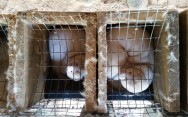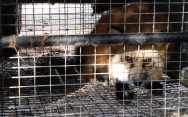Blog Archives
Home -
Archive by category "Anthropology"
A solar eclipse is a temporary, but dramatic event that humans historically have striven to
understand, whether they arrived at mystical, religious or scientific conclusions. Humans, however,
are not the only animals to react to an eclipse of the sun. So far there have not been extensive
studies of what animals do when confronted by a solar eclipse, but scientific research emerging out
of the April 8 th eclipse might reveal how animals react to a total eclipse of the sun.
The results so far suggest that animals react in a number of different ways. The current
understanding also reveals how animals are sensitive in ways that humans may not be. Animals are
like humans in many ways, and one of these ways is that all animals are different, and have different
capabilities, heightened senses and social understandings of their environment.
For example, Jane Goodall observed chimpanzees pointing at a solar eclipse and screaming. Baboons
were observed increasing their grooming behavior, which is often associated with a stress response.
Other research observed animals launching into nighttime behaviors as if it was time to sleep.
Overall, animal behavior was diverse across different species, as some birds began singing new
songs, some spiders began weaving a different kind of web or breaking their webs, and many other
behaviors were observed that may have meaning only to the animals. Many animals displayed
anxiety and some animals, such as bears, were indifferent. Galapagos turtles began attempting to
breed during the eclipse.
Animal sensitivity could cause certain reactions in animals, to changes caused by the eclipse.
Photosynthesis drops during an eclipse, and charged particles in the atmosphere can cause heat
fluctuations and solar winds. Animals sensitive to oxygen, C02, temperature and wind could be more
acutely aware of an eclipse.
One thing that animal reactions teach us is that animals are not a block – they are many different
species of beings that share the earth with us and react differently to various stimuli.
A number of projects have begun researching animals’ response to the recent solar eclipse, and
they have invited the public to share their research findings from the eclipse. All animal research
should be conducted humanely and without harm or stress caused to the animals. Please support
research projects and gather research that does not harm animals. https://youtu.be/-fkgb4yBUuk?si=gYjpncxlNX-w3lmm
In an exciting breakthrough for research in animal communication, the SETI institute managed to
have the first ever conversation with a humpbacked whale. The SETI institute began as a NASA
research program to understand and search for life beyond earth. The Whale-SETI team is using the
mathematics of information theory to understand terrestrial, non-human communication as a way
to develop filters to apply to any communication with extraterrestrial life.
Humpback whales are social and intelligent creatures who make tools and communicate with songs
and social calls. The Whale-SETI team has been studying humpback whale communication, which
include “contact calls” that whales use to communicate their presence to other whales. The team of
scientists from the SETI Institute, UC Davis and the Alaska Whale Foundation played the contact calls
into the sea via an underwater speaker, and a humpback whale named Twain approached and
circled the team’s boat while responding in a style that matched the original contact signal. The
researchers managed to have a 20 minute conversation with Twain. It is the first known
“conversation” between humans and humpback whales. Humpback whales also display non-audio
communicative behavior when they blow bubble rings in the presence of humans.
Whale SETI may be viewed as a springboard for communicating with extraterrestrial life. However
communication with animals could have more immediate benefits for animals in our world, right
now. Whales are one of the marine creatures who are profoundly affected by human activity. Whale song is disrupted by the noise of ships. If we can communicate with non-human animals our decision making should consider them as equal participants.
Humans have erroneously viewed human communication as synonymous with superior intelligence.
Without the ability to communicate with other animals and with a so-called superior intelligence
human activity has rampaged throughout animal habitats without the consent of animals. Every step
towards understanding animal intelligence and communication provides further evidence that these
assumptions are wrong. Scientific knowledge should not dictate our respect for non-human animals,
however scientific discovery can provide a basis for progressive animal rights policy and zero
tolerance for cruelty towards non-human lives.
|
Tags: Animal Communication,
Animal Habitats,
Animal Intelligence,
animal rights,
Humpbacked Whale,
Kevin Boileau,
Marine Animals,
Nazarita Goldhammer,
Transhumanist,
Whale Communication,
Whale Song
Many countries and states have been waking up to the need to enshrine the rights of animals and the environments in law. European countries in particular have been setting a trend in passing laws that recognize animal rights and introduce punishments for animal cruelty. What countries are passing these laws and what are the limitations?
Spain
Spain has recently passed laws that increase punishments for animal mistreatment. Amongst other changes, it has also made training classes for dog owners mandatory and made it illegal to leave them for more than 24 hours. In 2020 Spain also passed laws that allowed for joint custody of animals in divorce, recognizing that companion animals were “sensitive, sentient beings” rather than property.
Switzerland
Switzerland is known for having animal rights laws that are stricter than other countries. The right to animal dignity is constitutionally protected. In 2022, Swiss people failed to vote for a law that would have banned industrial farming.
Portugal
In Portugal there is a law that criminalizes abuse and neglect of pets but it has faced challenges because animal protection is not enshrined in the Portuguese constitution.
Netherlands
The Netherlands may soon ban harmful breeding of pets.
What are the Weaknesses of Animal Rights Laws?
One weakness in animal rights laws is who we choose to protect. This means that some animals are considered more worthy of protection than others, for example there are more laws to protect companion animals than lab animals. In the case of Spain’s new animal protection law, people have protested that the animal cruelty laws don’t protect hunting dogs and farm animals. The laws also don’t affect bullfighting, one of the cruelest “sports” involving animals.
The manner in which animal protection laws are introduced often says a lot more about what is acceptable or normal for humans than it does about what animals need or deserve. It’s a positive thing that animal sentience is being recognized in divorce and pet custody. On the other hand, it’s easy for people to understand companion animals as an accessory to human existence. Meanwhile other animals like lab animals, farm animals and invertebrates are frequently under-protected in the law. Many other animals that don’t meet the definition of who humans consider to be intelligent or worth protecting aren’t legally protected. As laws to protect animal welfare proliferate, we need to locate the decision-making process within a new transhumanist framework in which our human perspective is de-centered and animals and ecosystems perspectives are at the center.
Giving animals, trees and rivers legal rights is no longer a fringe idea. The Law Society, the professional body for solicitors in England and Wales, has produced a report that says that granting legal rights and protections to non-human entities such as animals, trees and rivers is critical if nations are to confront climate collapse and the collapse of habitat and biodiversity.
The report is called Law in the Emerging Bio Age. The title indicates the big shift in thinking when it comes to humanity’s view of our place in our environment alongside other creatures. The idea that we live in the “bio age” is correct. Humans can no longer rely on the conceptual framework of the Western Christian tradition, in which we are outside nature and have dominion over nature. This attitude has brought us to the brink of the extinction of our species. It has destroyed whole species in the great age of extinction caused by pollution and human activity.
It’s time to move beyond the destructive power of exploitative traditions that inform our law and our societies. We can look to societies and nations that are informed by indigenous traditions for inspiration. Ecuador for example, has enshrined legal rights for the natural world, based on the tradition of respecting the earth mother goddess, Pachamama. Bolivia has also granted rights to nature. New Zealand has granted personhood to a former National Park, Te Urewara Park, the Whanganui river and Mt Taranaki.
In the West, in certain countries and states, the law has started to consider that animals should be defined as people rather than property in divorce cases.
These changes represent promising new seeds, but more has to be done to protect the vast swathes of the earth and its creatures that are vulnerable to human exploitation. It is time to accept that we live in the “bio age,” and time to build a new legal and political framework to legislate for our connectedness to natural and animal life.
Read More:
https://vjel.vermontlaw.edu/rights-nature-movement-closer-look-new-zealand#:~:text=Rather%20than%20incorporate%20a%20rights,Taranaki.
https://www.theguardian.com/environment/2022/oct/10/give-legal-rights-to-animals-trees-and-rivers-say-experts
Until Wildlife Services agreed to “cut back” on killings of wild animals in Montana, it might not have been visible to most Montanans that thousands of animals were being killed in Montana every year. In 2018, the most recent year for which data is available, Wildlife Services killed 7,965 coyotes, 46 wolves, one grizzly bear and other species in Montana. Until the settlement with WildEarth Guardians required Wildlife Services to stop exploding sodium cyanide bombs on certain tracts of public and private land, Wildlife Services’s explosion of bombs to destroy animal habitats wasn’t a subject of discussion.
The massacre taking place under our fingertips is still taking place, only at reduced levels. Wildlife Services is an anachronistic name for a violent agency that mostly appears to protect the interests of big farmers and ranchers. Public understanding of these agencies is that they restore balance in livestock predator conflicts and to human/animal interactions. Yet the activity that most undermines balance is protected by Wildlife Services: the livestock industry that endangers the planet through climate change and pollution. The whole system is one in which countless numbers of animals (including cattle) die to feed a machine that requires more killing to perpetuate its existence. By definition any system running on this level of destruction is not sustainable.
WildEarth Guardians have won a battle that requires the Wildlife Services to turn to science to justify their killings; they are now required to review the killings based on updated reports rather than carry them out wantonly. Unfortunately, it has not won the war. Winning the war is only possible when human groups participate in protecting an environment shared with non-human creatures equally.
Read more:
https://montanafreepress.org/2020/05/14/wildlife-services-to-cut-back-killings-pending-environmental-review/
There are times when a death toll goes so high that the significance of numbers is nothing but the complete loss of their significance. No longer are numbers able to speak of the loss of the individual to a community, to a family, to a habitat. The only thing they are able to speak of is the loss of meaning, the incalculable damage done to life itself. When we hear of a human death toll – a disaster, a massacre — the number of dead hits us like a blow to our sense of individual destiny: the right we think we have to thrive, to matter. The dead are like a wave that sweeps across our consciousness, constantly overwhelming our efforts at recognition, at the distinction we humans find between ourselves and others, our environment. We are connected with others in our helpless masses, no longer as helpers or community members, but as mere victims. The numbers stand while we fall, unable to resist the magnitude, the amplitude of the loss.
The numbers of estimated animal dead in Australia cannot be compared to a human village, nor a town, nor even a nation. Instead, the numbers of estimated animal dead in Australia’s fires make up one eighth of the world’s human population today. This animal death toll doesn’t even include frogs and insects.
As humans, we work among the ruins of our own disasters to regain our personal significance. We cling on to activity: gestures of solidarity, statements about change that are as much made to feed the ego as to stake out a real commitment. We reassure ourselves that we are individuals, that we matter. In the wake of Australia’s fires, humans feeding baby koalas and wrapping them in blankets are broadcast as a signal of activity that fills the void of disaster. They speak of our ability to care, to matter, as helpers and agents for animals. Despite the great good of these activities, they do not speak of the loss and grief of animals themselves, nor of their situation as displaced individuals and families who have been devastated by Australia’s inadequate climate change policy.
The animals who have survived have lost their family members and in some cases their entire habitats or livelihoods. The best known example is the Koala, which has been decimated by the fires on Kangaroo island. These koalas had represented a sanctuary and a reserve, protected from the chlamydia that has kept other koalas from reproducing successfully. There are questions over whether a small marsupial which lives its life shielded from danger in greenery has any real shot of sustainable existence in its hollowed out home on Kangaroo island.
We humans imagine death from fire as striking these animals with explosive might, but before the fires, animals were already dying of exposure to intense heat. Birds were dropping out of trees. Animals were starving because their food supplies were drying to a crisp. The fires that have grabbed human attention have left animals homeless. Those who have survived and haven’t received medical attention are enduring great suffering from hunger and injury. The Australia fires have unearthed a world of animals who carry on their lives whether we notice or care or not.
We need to follow the story of animal lives beyond this crisis as they now evade opportunistic predators like feral cats, as livestock dead create bio-hazards for animals, as they move about and use their ingenuity to survive but often fail to make it. Animals, like humans, do what they can to survive, including sheltering together in wallaby burrows. Heroic working dogs have rescued animals from fires. The sight of injured animals, baby koalas clutching stuffed animals, should remind us that other species have their own emotional needs and communities. Everyday animal lives, not human heroism, are the ignored clues to helping animals and working alongside them. For example, it should have been clear by damage from the heat wave in Australia, and by animal behavior, that climate change disaster was already preying upon the animal population. The fear is that California “will be next.” The sovereignty of animal lives needs to be consistently observed and recognized outside of disaster scenarios. Waking up to animal sovereignty, animal pain, animal solidarity can transform the death of animals from a number into an accountability for the loss.
The rescue efforts are not going to stop when the fires start to disappear from the headlines. This article has some information on how to support the rescue efforts going on: https://www.cnet.com/how-to/australia-fires-have-killed-more-than-a-billion-animals-so-far-how-you-can-help/ However, ongoing donations to animal conservation organizations such as the World Wildlife Federation are needed indefinitely. Commitments to fight climate change and move away from animal exploitation and death are needed Right Now.
https://www.latimes.com/environment/story/2020-01-14/australia-fires-killed-millions-of-animals-kangaroo-island
https://www.cnet.com/how-to/australia-fires-have-killed-more-than-a-billion-animals-so-far-how-you-can-help/
https://www.nbcnews.com/science/environment/more-1-billion-animals-killed-australian-wildfires-n1112326
This, therefore, is not an a-historical, neutral situation. In actuality, it is dire. This changes the moral analysis from any traditional moral footing (deontological, teleological, aretaic, or casuistic). We simply do not have time nor luxury of “niceties” to engage in leisurely dialogue. This is why I just wrote my new book on responsibility–we are in a crisis, and if we don’t disengage from master signifier that revolves around my thesis of semio-capitalism – – – we push ourselves and many other species to the brink of disaster. This is not sci-fi, nor hysteria. This is cold, hard truth. Yet, so many of us continue to directly or indirectly exploit non-humans, exploit clean water, exploit the ground, and exploit other humans. This is no time for exploring a “complexity of issues” in the same way we might if we were not in crisis. We need to change our behavior now. Unfortunately, the research shows a trend toward evolutionary DE-selection for empathy, and DE-selection for deeper moral reflection. Hardly anyone outside of some university disciplines understands basic moral principles and basic moral reasoning, which is catalytic for moral subjectivism, dangerous forms of hysteria (not Zizek’s), and capacities for violence. For another group–usually the rich and fat bourgeoisie–this situation causes neuro-overload, which leads to subjective constellations of obfuscation, complacence, and bitter cynicism.
As you know, several of us are grinding away day and night to solve the problem of moral motivation– its lack–and the Reality is stark. Most humans are not motivated internally by “good” reasons. Most are motivated only when their own interests are threatened, which shifts game strategy from positive to negative, and win-lose social dynamics (that are supported by psycho-pathological discourse about capitalism). Moreover, being responsible for one’s self, or one’s kin, or one’s family is insufficient in this situation. Even Sartre came to realize in the late 50s that moral reasoning was mediated by one’s historical-social circumstance–Zizek agrees with him in their confluence of ideas about Kant’s categorical imperative. We need to find the imperative, from which we derive perfect duties. This does not fall into the either-fallacy but instead is a transcendent knowledge that requires us to act in certain ways no matter what. This is still the brilliant reverberation of Kant’s legacy. This also explains the Levinas’s reversal of Kant’s core requirement of autonomous reasoning. In this reversal, Levinas (and better explained by our mutual friend, Roget Burggraeve), autonomy (and internal moral reasoning) fails as moral motivation precisely because we live in the “age of desire” so well formulated by Foucault’s trenchant attack on Freud). This is the appeal of the Other–the radical Other–the non-human Other, that most humans choose not to see or to recognize.
This hubris is our downfall. It is bitter and disgusting. Childlike. An inversion of the reality of the self–that is, the self is empty in its very nature as conscious transcendence, yet we continuously fill it with those obscure objects of our desires (as Lacan in his genius demonstrates all too easily). When we should be emptying ourselves, instead we fill and fill and fill. This is the anthropological mistake of humanism and of the Western Enlightenment, in my view. It is an ontological problem that cannot be solved by psychotherapy, counseling, or spiritual guidance because they are human artifices that dwell on the addictive arrow of the ontic/optic. The facts are here. Don’t take my word for it. We are literally throwing ourselves over the cliff–and all other sentient beings with us–and still we try to “rationalize” (Freud), obfuscate (Jung), or lose ourselves in structural positions that are effete, and that will not offer us true praxis. More regionally, very few residents of this great state recognize that Montana is becoming the next Colorado, and that Missoula is becoming the next Madison, Wisconsin. But make no mistake – our non-human cousins, our own children, water, land, and the very air that we breathe are already being sold. In time the “university” here will be nothing more than the handmaiden of semi-capitalism– our own fear leading to our very destruction. Look at the evidence. Do the math. Then figure out who YOU really are–what YOU are doing to do about it TODAY. Again, with all due respect, there is no time for political correctness, niceties, and bourgeois etiquette.
Let’s imagine that humans meet a superior species – stronger, smarter, and more vile than we are. They chain us, train us, experiment on us. They force us to entertain them, and they hold us captive for rape. They hunt us, trap us, and take pictures of us when we have been “harvested.” They cut us into pieces, tear our skin from us, throw us into boiling water, and make words about ecosystems, wildlife management, and the “natural” way of things. Then we will finally ponder ontological parity, virtue, empathy – making all sorts of “moral” claims about justice and fairness. In response, some won’t care, some will cut with greater precision, some will ignore us, and others will laugh, sadistically. Our bourgeois universities will “smoke” their books with more intensity until they, too, perish in the Great Annhilation – the New Holocaust. Then, there will be others who awake to the truth of things and realize that our dream of fertility, Western expansion, colonialisms, violence, and eugenics is truly what we have known all alone – a National Socialist nightmare that is coming to your door.
Just as the world’s most recent ape species was discovered, their habitat is about to be decimated. The Northern Sumatran Tanpanuli Orangutan was only discovered last year, and the population is already known to be the most endangered ape species in the world. The orangutans are threatened by Chinese diggers constructing a hydroelectric dam that will divide their habitat in two.
The dam has been opposed by leading environmentalists. Research in top scientific journals has shown that its impact will be disastrous. Yet it still goes ahead because of an injection of funding from the Chinese State Bank. Other major funders have pulled money based on the impacts on the orangutans, amongst other things. The reason why this disastrous project is being protected is that it is part of a huge Chinese plan for infrastructure to facilitate trade. Projects like this will spring up elsewhere, harming other wildlife.
Videos show orangutans clawing at diggers who are moving into their habitat. Orangutan literally means “man of the forest.” We must stop the advance of human works of such magnitude and harm. The vulnerable are counting on us. Please sign and share.
See Also:
https://news.mongabay.com/2018/07/scientists-urge-indonesian-president-to-nix-dam-in-orangutan-habitat/
https://www.theguardian.com/environment/radical-conservation/2018/apr/23/worlds-newest-great-ape-threatened-by-chinese-dam
This last week, the world has been in mourning for Koko the beloved mountain gorilla who learned to speak in American sign language. Koko was born on the 4th of July 1971, hence her name “Fireworks-child” (in Japanese), shortened to “Koko.” This fireworks child was a prodigy – she learned to play the recorder, and to sign over 1,000 signs and understand 2,000 words of spoken English. Koko was sad when she lost a pet, spoke about her longing for a child (the pet kitten was a close substitute) and talked about death and her own death. She also played with words and mixed them up in new combinations. She once described herself as a “fine-gorilla-person.”
Did humans teach Koko about language, or did Koko teach humans? Koko could speak in sign language,
but also more importantly, she could listen. When she listened, she interpreted things in her own way.
Despite criticism of the Koko project (which stated that Koko was mimicking her trainers), Koko
responded in unexpected ways. When she was asked where gorillas go to when they die, she said
“comfortable-hole-bye.” There were a few occasions when she expressed deep sadness and grief, like
when her pet kitten was hit by a car and killed.
Language is often used as an excuse to elevate humans above other animals. There were scientists who
felt Koko’s use of language was meaningless, as she didn’t learn grammar and syntax. But throughout
her life, Koko used sign language not as a lifeless toy or tool to get food and water, but a way to
communicate and describe her world. Communication –- rather than language –- was the key. Koko
and her researchers built a rapport together, where words could mean more than the dictionary
definition, they could mean complex emotional states and refer to shared understanding between
Koko and the researchers. Above all, what Koko taught us is that language is a human invention, but
communication is common to all animals. For that, we owe a debt to Koko, our Gorilla teacher.








Social Media